Memorials for the Living: 23 Men in a Boat.
The sinking of Oakcrest by U-123
by Ian Campbell
The Battle of the Atlantic was the dominating factor throughout the war. Never for one moment could we forget that everything happening elsewhere, on land, at sea, or in the air, depended ultimately upon its outcome. --- Churchill
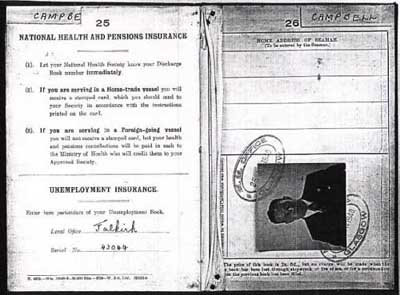
On the face of it the three entries in a seaman's last discharge book seem bald statements.
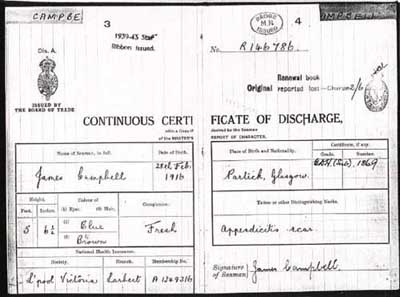
MT Inverlane, no.159816; 5493 tons; Port of Registry: Glasgow; Engaged: 19.9.39; Rating: Steward; Conduct: Very Good; Description of Voyage: Foreign.
Only the 'Discharge' heading gives any hint of a tale:
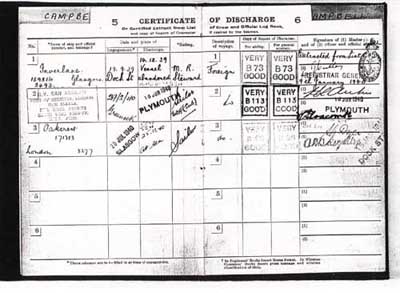
14.12.39, Vessel Abandoned, 55o05'N, 01o07'W.
The next two are more mundane:
M.V. San Adolfo, 164464; 4376 tons; 4500 hp; Port of Registry: London; Engaged 29.2.40, Greenock; Rating: Sailor; Conduct: Very Good; Description of Voyage: Foreign; Discharge: 18.6.40, Plymouth. S.S. Oakcrest, 171313; 3277 tons; Port of Registry: London; Engaged: 20.7.40, Glasgow; Rating: Sailor; Conduct: Very Good; Description of Voyage: Foreign.
It is the 'Discharge' column that says it all, sums up both the voyage and the adjustment the Merchant Navy had made by a year and more into the Battle of the Atlantic: a handwritten scrawl, not water-stained or blurred, for this is a replacement book, not an original, and paid for, but nonetheless hasty and brief:
17W, 53N, 25.11.40, at sea.
Although there is a sense of urgency, an abruptness and approximation to the figures, they do not reveal what happened. These details are 'extracted from log and list'; i.e., from one held ashore of the seaman's signing-on details, not from the discharge book itself. Family oral history holds that Oakcrest was little more than a coaster, built for the Mediterranean. Certainly she was pressed into long trans-ocean service only by generous Government insurance cover and the fact that the U.K. was losing to enemy action over a quarter of a million tons of shipping a month. In peacetime Oakcrest would probably have been quietly rusting away in some backwater, too small and old to be venturing profitably anywhere, let alone the North Atlantic. Instead, with a single, probably pre-Great War gun on her stern to ward off surfaced German submarines - the U-boat of the second of two dreaded World Wars - forty crew, and a single RN DEMS ("Defensively-Equipped Merchant-Ships") gunner, she had plied her way across 'the pond', perhaps once, perhaps several times. Through the U-boat-infested Western Approaches to the British Isles, through the dreaded 'Black Gap' where there were no Royal Navy escorts or long-distance aircraft cover, to Halifax, Nova Scotia, and on to New York. Like Inverlane and hundreds before her, she had perhaps survived the outward journey, and come home safely once already. This trip she was heading out, a member of convoy OB-244 for New York, torpedoed and sunk among six others, in the early morning of 23 November, 1940; one by U-103, five more by U-123.(1)
This was in an intense period for the Atlantic campaign: a month after the mythologised slaughter of convoys HX-79 and SC-7, when German tactics had romped ahead of British technology and numbers, attacking on the surface at night, where ASDIC could not detect the U-boats and there was no radar to pierce the darkness. U-123 was among the U-boats which attacked SC-7, sinking Boekelo (2,118 tons, Netherlands), Clintonia (3,106 tons, British), Shekatika (5,458 tons, British) and Sedgepool (5,556 tons, British), all on Saturday 19 October 1940. The slaughter of these two convoys was mythologised in that their extremely high losses were taken during the war, but more so after, as the norm, the standard. Look, for instance, at recent popular books and documentaries about the Atlantic campaign, such as "Anti-Submarine Warfare: the Battle Of The Atlantic" (Decisive Weapons, BBC-TV, 1996); "Atlantic War", War Stories (narrated by Edwin Newman, no publisher given, America, 1993); "Black Pit: Convoy SC-107", War At Sea, National Film Board of Canada, 1995; and Secrets of War: "the Battle of the Atlantic." (The Documedia Group/Pearson TV, 1998). All concentrate unrealistically on such unusual, historic convoys. This is to the detriment of the history of the campaign, as it obscures the real circumstances of the events. It is also to the detriment of all the participants, as they ought to have their story told more as it was, not merely as media and publishers, all desiring a "better story", usually make it.
In actual fact very few convoys at any time during the war lost more than a couple of ships. No less than 97% of Allied convoys made their voyages with a single sinking or less, and 90% were never even sighted by U-boats or aircraft. The horrifying losses of the Allied merchant navies, the 35,000 men and 2700 ships lost, were concentrated in less than three dozen historic, famous Atlantic passages. These unhappy few served as the public memory for the rest: the forgotten, routine majority. Their monuments went unrecorded: the battles not lost, the populations not starved or surrendered, the invasions and campaigns carried to successful conclusions, the D-Day's and Anzio's and the VE-Days. Their only record was as numbers and statistics, and the always submerged, unrecalled legacy of fear and stress: the unavoidable sensation of apprehension and worry which travelled everywhere with the merchant seamen, the escort sailors, the Coastal Command airmen, and the U-Waffe crews too: this could be the one. This time I could get the chop - we could get the chop. It was this that created the intensity of memory and trauma they all carried to their graves, not the losses and the deaths, which were concentrated in pulses of sinkings and surges of victories, as both sides teetered back and forth on the seesaw which made up the technical and strategic battle being fought. It was the fear they could never shed that stuck in all their minds.
At this time RN escorts were still few, overworked, poorly-trained, lacking radar and radio-interception equipment, and limited by low radius to escorting merchant ships in convoy a few hundred miles from the coast. A single overarching RN Western Approaches Command would not be set up till the following February. RAF Coastal Command air patrols and escort were also few, limited in range, and lacked radar and accurate navigation. They had no weapons capable of dealing with a U-boat, surfaced or otherwise. Comparatively sluggish type IX U-boats like U-123 were safe. Their newly-adopted tactics were to operate in groups: rudeltactik: "wolfpacks", and to loose torpedoes from the surface at night, where they were all but invisible to ships or aircraft.
The discharge book's bald statement does not say Oakcrest was underpowered or too small to be convoying. Tonnage suggests age: ship designs tended to get larger, rather than smaller, as crewing numbers and running costs were little greater for 10,000 tonners than 5,000 tonners, little greater for 5,000 tonners than 3,000 tonners. She may even have served under another name, or many, prewar, and in the Great War. There were plenty of pre-Great war vessels in the decidedly 'greying population' of the British Merchant Navy. Nor does the Discharge Book say, as family oral history does, she was carrying steel plate, torpedoed, and sank in only seven minutes. Two of the crew got into a lifeboat which was lowered and fell astern, and were never seen again. Those still alive got into the second lifeboat, one man, James Campbell, jumping from the side of the ship and breaking another man's collarbone.
The North Atlantic in winter is still feared and respected in a way no other frequented route is, save Cape Horn. Under Lloyd's Register, and on the Plimsoll Line which shows the safe loading marks and the correct waterline, there used to be six marks: TF, F, T, S, W, WNA: Tropical Fresh, Fresh, Tropical Salt Water, Summer Salt Water, Winter Salt Water, and WNA...Winter North Atlantic. These marks show just how deeply a ship can safely be loaded in water of varying temperature and salinity, and thus density and displacement. Only the North Atlantic in Winter has a whole Plimsoll mark to itself. Even today, in the age of radar and sonar, of satellite navigation and helicopter rescue, the North Atlantic continues to sink ships and kill seamen, often with as little trace as sixty or 600 years ago.(2)
In the North Atlantic, in winter, continually taking water over her sides, the boat drifted North-East for between eight and eleven days. Twelve men died of exposure and injuries in that time, including the man with the broken collarbone, and were consigned to the deep. Some were in clothing needed by the living, some not. In a storm, the boat, still with a foot of near-freezing seawater washing round in her, sighted land, and the boat made the shore one 'dark and stormy night' in December 1940. By chance, they had fetched up, off a narrow gully, on the west coast of Barra in Scotland's Outer Hebrides, but not before two more men, in sight of safety, let slip their hold on hope and died.
The boat did not even safely beach in the narrow rocky gully, on a storm-racked coast surrounded by cliffs. "It looked fearsome on a quiet sunny day with a one metre swell. At night in a storm it must have been like a giant washing machine full of boulders."(3) At the last moment it broached, side-on to the sea, capsizing, hurling the exhausted survivors into the water, and crushing two. The men, all frostbitten, collapsed onto the beach. After eighteen hours, from dark until mid-morning, two still on their feet went for help at a farm half a mile away. They were only a couple of miles from the main settlement, Castlebay. By a last, vicious, twist of fate those from the farm who came back with the survivors recognised one of the men who had died earlier, John McKinnon, not consigned to the deep because the rest were too weak and cold. Had he held on but a little longer, that night he could have been by the fire in his own home there on Barra.(4)
The boat did not even safely beach in the narrow rocky gully, on a storm-racked coast surrounded by cliffs. "It looked fearsome on a quiet sunny day with a one metre swell. At night in a storm it must have been like a giant washing machine full of boulders." 1 At the last moment it broached, side-on to the sea, capsizing, hurling the exhausted survivors into the water, and crushing two or three. The men, all frostbitten, collapsed onto the tiny shingle beach of Bagh Heige. Two survivors who could still walk went for help at a farm half a mile away. They were only a couple of miles from the main settlement, Castlebay. By a last, vicious, twist of fate those from the farm who came back with the survivors realised they knew one of the men who had already died of exposure from being in the water after the torpedo hit, 22 year old John McKinnon. Had he survived, that night he could have been by the fire in his own home on Barra.

From the relatives of another survivor, John Adams, we now have an evocative description of the landing of the survivors early in December. His niece Cherry Campbell, no relation, and her mother visited Barra in 1998 and spoke to islanders who recalled the events. Mr MacNeil (84 years old in 1998) remembered that the first house to take the survivors was Roderick Neil MacNeil and his wife, at Tangasdale, a little inland from the beach on the western side of the island.3 A daughter, a retired teacher, still lived there in 1998. She was a youngster at school at the time of the landing - her mother was milking the cow when she was first aware of men coming from the shore around the hill.
-
We were able to talk to Miss and Mrs MacNiel (in her 80s) across the road. They kept
repeating "It was an awful day."
We asked "Was it a common occurrence?"
''Thank God, No'."
Miss MacNeil said it was early morning, her mother was milking the cow in the field (It would get light in December at that latitude at 8.30-9.00). She was leaving for school - perhaps around 8.30, so it must have been at least Monday, 2 Dec 1940. They saw yellow oilskins on the hill, climbing. Because of Loch na Dorlinn and Loch Tangasdale, the Loch of the Black Cascade, which lay beside the beach in front of the settlement of Tangasdale, the men went round the back of the loch, circled round, and appeared over the hill from inland. This was also remembered vaguely long after by James Campbell, that the men from Oakcrest who went for help were halted in the dark by the noise of water, and waited for better light to move around what they thought was a stream or loch. This can only have added to the time and strain on these desperately weary men.
Her mother gave them whisky - the Doctor was cross, naturally, as alcohol to the hypothermic and shocked can induce blood away from the vital organs and cause coma and death. She was shocked - she didn’t think her mother had any whisky! Yet another connection to the humour and moral tale of the film Whisky Galore.
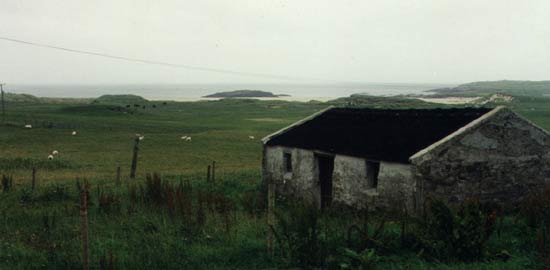
They said that they got wheelbarrows to get the men back to the houses, because they were in such a terrible condition. Their legs were so swollen, they had to cut their seaboots off. They had been adrift, Mrs MacNeil said, for 9-10 days. They were desperate for fresh water, and drank too much, too fast. One died from drinking too much from a stream, after drinking nothing for a week. This may have been the result of relaxing after their ordeal, as Jim remembered it. The survived to reach a house in Tangasdale. "One man lost a leg. They were in terrible condition. Some older, some younger." One who died was a big Irishman. His wife came back later. This would probably be the Bosun, Whitty from Waterford in southern Eire. The family visited Barra many times until quite recently.
The crofters were told not to overfeed them. She remembered one survivor saying "is that all we get?" Lorries took the survivors away. The Doctor treated the sick at the house, (they stayed two days?). Some of the men were initially cared for in the houses at Tangasdale, then taken into other houses in Castlebay.
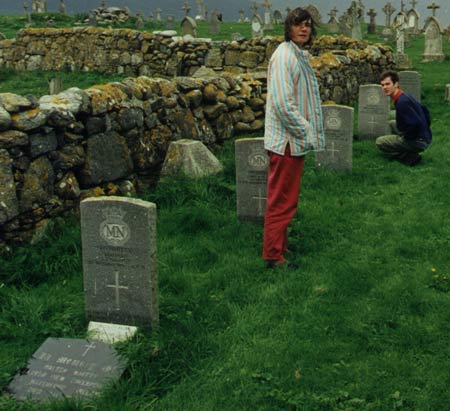 One man came from Barra. He was one of possibly 24 inital survivors, perhaps 12 of whom
made it almost to the shore. The survivors thought they were off Donegal in Western
Eire. The open lifeboat they had spent the ten days adrift in was wooden, with oars.
One man came from Barra. He was one of possibly 24 inital survivors, perhaps 12 of whom
made it almost to the shore. The survivors thought they were off Donegal in Western
Eire. The open lifeboat they had spent the ten days adrift in was wooden, with oars.
Like Jim, John Adams rarely spoke again of the events. "Whilst recuperating, he had spoken of the ‘white beach far north’, but I doubt he’d recalled the horrors to his kid sister." Cherry reports. He was unfortunately killed in March - April 1942, we think on an arctic convoy. After recovering from the ordeal he had wanted to take a more active role in the war, and had joined the RN. We are still investigating the circumstances of his death.
The survivors who died still on Barra were buried above [left photo] the beach under four slim granite Imperial War Graves Commission headstones ["sent by the government"], with the Merchant Navy (MN) crest.4 One more was returned home at the request of his family.
| W. Whitty (from Waterford) | W. Daley | W. Carr | M. Fenton |
| Bosun | AB | Fireman & Trimmer | 1ST Radio Operator |
| SS Oakcrest | SS Oakcrest | SS Oakcrest | SS Oakcrest |
| 1 December 1940
Aged 39 |
1-2 December 1940 | 1 December 1940 | 1 December 1940 |
The six survivors of forty-one rested and were sent home.(5)
James Campbell's replacement Discharge Book (charge 2'6d), was signed on 15 January 1941. All the survivors had grievous exposure injuries - what had come to be called Immersion Foot, the result of limbs unavoidably kept in near-freezing water for days or weeks. James Campbell lost both legs below the knee to frostbite, and only preserved his hands through the ordeal by keeping them tucked in his armpits. He spent a year in hospital with double pneumonia. After amputation he received tin legs, though the doctors said he would never walk again without sticks, from the age of twenty-four. Jim said "I'll never walk with the bluidy things!" and threw them away. He was and remained an obstinate man. As the war ended he took a night school course in accountancy, with a wife and two children to support. In Glasgow, near Blackpool, and then in Kent he worked as such, until his death in 1977, seeing his heart's desire, Sydney Heads once more from a ship, during a visit to Australia in the summer of 1975-6.
By November 1940 James Campbell was already, unlike many merchant seamen who had joined up 'for the duration', no stranger to either the sea or disaster. Running away to sea from Glasgow at age 16 in 1932 like his elder brother John before him, he had travelled the world under the 'Red Duster', the ensign of the British merchant fleet. It had always had this flag, never seen as a navy, or an arm of the state, from within or without. Only the Great War had given it even the merest indication that such status or position could exist. At the commencement of war in September 1939, Campbell was in port, joining a ship a fortnight later, sailing, perhaps in convoy, to Abadan outside Khorramshahr in 'the Gulf', bound Invergordon on the Firth of Forth with 12,694 tons of fuel oil. We have already seen her fate: 14.12.39, 55o05'N, 01o07'W, vessel abandoned. Somewhere off Newcastle the ship, a motor tanker, ironically built in Germany only three years before, was mined, probably by one air-dropped by the Luftwaffe. Close to shore, in autumn, they got to land safely, save four killed by the explosion, and the tanker broke in two, the aft section beached off Whitburn Steel. Later the fore half was used as a blockship, sunk at Longhope in May 1944.
Campbell's next engagement was another tanker, for another company, signing on to the ship as all men did; not to a ministry or to a government department, but to a ship and a company, while the company took the insurance for the voyage, and the government requisitioned the ship and filled it with cargo by way of the Ministry of Wartime Transport, the MoWT. MV San Adolfo came and went to her destination safely, though family members say she was bombed in port somewhere; records and oral history do not report. James Campbell said "the bomb fell, the captain's boot-soles disappeared between the deck rails and I thought 'if its good enough for him, its good enough for me.'" This type of danger-disarming tale, shrugging off the tension and shock of a loaded tanker being bombed while stationary alongside in port, is typical of MN and indeed all war stories and adventure tales related by men the world over. Such narrative styles kept the reality of war at bay.
Campbell was an ordinary seaman inside the wheelhouse (lined with concrete slabs to make it cannon-shell-proof) when the vessel was strafed.(6)
Somewhere in the North Sea during their return from abroad, they met an already famous destroyer with an already famous captain: HMS Kelly, commanded by Mountbatten. Kelly had been torpedoed, her back almost broken. Campbell always spoke of being at the wheel when the ship's master used a loudhailer to enquire "if there was anything we could for you sir?" Mountbatten replied "No - quite all right, carry on."(7)
His ship would live - and he managed to bring her safely to port, her starboard rail awash, where she was repaired and continued her short, eventful life. 'Batty' and Kelly were immortalised in 1942 by Noel Coward's film In Which We Serve. San Adolfo continued on her way.
Engaged in February, Campbell was discharged in June at Plymouth, the ancient port of William Bligh's birthplace two centuries ago, and long before, that of Drake. Four months of waiting followed. War had not yet caught up with trade and the needs of rapid loading and unloading of goods and fuel. More time, space and opportunity were lost in delay and/or mismanagement, as well as repairing damage, than action. Later San Adolfo would almost play another small part in the fame and mythology of the Battle of the Atlantic: she was again in convoy in May 1941, and nearly earmarked to refuel at sea RN warships pursuing the German battleship Bismarck, the last great gamble of oceanic surface commerce raiding by the Kriegsmarine.
For Campbell, the period after San Adolfo was another wait; part rest, part itching to get to sea again where seamen belong, as they put it, before signing on to Oakcrest in July 1940, and apparently an unusual longer wait (July-November) before heading out in OB-244 to be sunk only a few days later. Men, if their ship came back, tended to leave and rejoin another, or the same one, with leave and rest in between, if only for a few days. Companies did not like men living aboard in port, no matter where. Working conditions were poor, and companies notoriously tight with money. Seamen tended to prefer the change, any change, to remaining where they were.(8)
Perhaps Campbell took a shore job awhile before growing tired of it, or merely wanting to be back at sea. Seamen were literally ten a penny and could, even in wartime, be got easily. Later in the war would come shortages, propaganda, encouragement, strikes and protests over pay and conditions, mass refusals to serve in certain ships or for certain companies. Later in the war also would come better pay and conditions, the end of the old, hated Navigation Act ruling that stopped men's pay when their ship was lost.(9)
Later there would be sufficient escorts, weapons and sensors, sufficient tactics, sufficient strategy. All this was in a future James Campbell never took part in. All of this was a future that need not have been necessary had such measures been taken prewar, to provide better ships and better accommodation, better training, better tactics and strategy, better escorts - any escorts. In the interim ordinary seamen and the authorities both did what they could, hoped for the best, expected things to worsen or improve, and failed to see the steady widening of the campaign.
James Campbell received for his wartime efforts and injuries the 1939-45 Star, which was awarded to all combatants and people involved closely in the war; the 1939-45 medal, for wartime service bravery; and the Atlantic Star, the campaign medal which all in the Royal and Merchant Navies serving in the Atlantic received: a simple straightforward five-pointed star, with a blue-green-grey ribbon, the colours of the Ocean they had fought upon. He also received a Mention in Dispatches, and the Oakleaf on the Atlantic Star Ribbon that signified this. Notification, when it came, was in suitably appropriate language, the like of which Drake, Nelson and Churchill had used:
Admiralty, Whitehall,
19th February 1942
Sir,
I am commanded by My Lords Commissioners
of the Admiralty to inform you that They
have learned with great pleasure that on
the recommendation of the First Lord the
Prime Minister has obtained the King's
approval for the Publication of your name
in the London Gazette as Commended for good
services in S.S.Oakcrest, in action with
the enemy. A copy of this letter has been
sent to the owners of the ship.
I am, Sir,
Your obedient servant,
H.V.Markham
|
Such language, to a mere able seaman! To you, from Sir Henry V. Markham, Permanent Secretary to the Board of Admiralty. One can almost imagine, as one is no doubt intended to, the collected lords and leaders of the Royal Navy clustered round a table, pondering the story of your sacrifice and singling it out for attention amongst a million others. "It is with baubles that men are led," said Napoleon, and though he was anything but a sailor, the idea holds true. Even today, half a century and more on, the language, itself of another era, and the tone, still "stiffens the sinews and summons up the blood!" as Shakespeare's Henry V put it. The weight and worth of five centuries of maritime tradition lies visibly upon the typed page like a pronouncement from on high - from, indeed, Their Lordships Of The Admiralty.
In common with almost all Great War and Second World War ex-servicemen, Jim rarely spoke of his experiences, even the prewar ones, to family or friends. Fourteen months in the Battle of the Atlantic poisoned eight years of intense, enjoyed, varied maritime life. The few tales passed to his son are the only record of his times at sea, as he left no written record, though he may have written one, in common with other veterans, had he lived into the Anniversary era.(10)
Until recently almost all have been silent, save senior men who published their memoirs in the years following the end of hostilities. For almost all Merchant Seamen, and most naval and air force personnel, a long silence descended over and around them and their life at war. Compared to the very many accounts of administration, operations, technology and famous events, mundane and ordinary experiences were neither popular nor sought after. The sensational and the extraordinary were posed as the norm. Outside these, there would be silences about the bravery, fortitude, and losses of seamen as well, compared to wartime official and media publication and promotion of their lives and times. For all their limitations, such limited propagandist wartime works at least promoted memory. Postwar, only seamen themselves wrote of their experiences, in ways which nonparticipants could read but not fully comprehend.
The reader will note many things are deliberately missing from this account. There is no exposition of life in the boat: what the survivors did, ate, said, sung, or thought. How they died, of what, and when, was not in the tales Jim passed down. They remained locked away from the world in his own memory, probably too harrowing to tell. The ethnic and social composition of the crew is unknown. There are no non-British names among the dead, save Reinwald, who was probably Norwegian. Nothing in this piece was synthesised or imagined from the mass of 'lifeboat literature' which festoons especially British MN accounts of the Battle. There is deliberately no gender, ethnic or class history in this account because it is restricted to what little was remembered or found about Jim, the ship, the U-boat, the events, and the time.
Commanded by Kapitän-Leutnant Karl-Heinz Moehle, U-123 was a large, long-range type IX U-boat. These were intended for ocean commerce raiding, in distant waters: the central and South Atlantic, and Indian Oceans. Prewar, like all U-boat designs, but gradually improved by the challenge and response of combat, they were typical of the many versions built between the wars, for various roles. They were slower to dive, and less maneuverable, than the favoured type VII, of which most U-boat production was comprised, but they had greater range, as much as 11,000 nautical miles, and the space for the stowage of food and extra torpedoes which made long-range missions possible and profitable.(11)
Karl-Heinz Moehle was born on 31 July 1910 in Norden, Ostfriesland. Some details of his career are provided on uboat.net. He joined the pre-Nazi German Navy, the Reichsmarine, in 1930, and served in surface vessels before shifting to the Nazi-era Kreigsmarine's illegally developed and burgeoning U-boat arm, in 1936. As such he was a member of a select elite, not only in pay and training, but also in that he shared equally the discomfort and danger and all-enveloping life of his ordinary submariners. He had commissioned a new small coastal type IIB, U-20 in 1937, after serving as a Warrant Officer in two smaller training boats. He had had a good war by late 1940, sinking 8 ships in six wartime patrols, mostly in the North Sea, before the prestigious commission of U-123. U-123 was to be his last front-line command, and in her(12) he sank the remainder of his 22 ships for 95,416 tons. In June 1941 he was posted to command of the 5th U-boat flotilla at Kiel, and then of the U-boat base there. He was promoted Korvettenkapitän on Monday, 1 March, 1943. Arrested in June 1945 and tried at Nuremberg for passing on to his subordinates the infamous "Laconia Order", he served five years, being released in November 1949.(13)
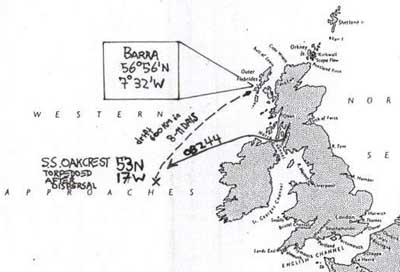
The Laconia Order stemmed from the rescue by U-156 of survivors of a ship containing Italian POWs as well as Allied passengers and seamen. The commander of U-156, Werner Hartenstein, called up two other U-boats and also gained limited permission from U-boat HQ. The group was then bombed by a USN Liberator patrol aircraft, causing many casualties. This incident prompted a blanket ban from Dönitz on further U-Waffe assistance of Allied survivors. This also led to a clear but secret policy from Hitler that Allied seamen should be deliberately killed, to aid the German war effort, which was against both the Geneva convention and the unspoken rules of the sea. No seaman will kill someone who one day may rescue him in return. Nor was the order common sense. U-boat men had dangerous enough lives already: if they deliberately killed survivors, there would be no, as against little, chance, of rescue by Allied escorts or aircraft. U-boat Head Admiral Dönitz quietly disagreed with Hitler, though some of his subordinates, including Moehle, were less than clear about Hitler and Dönitz's exact stance on this. Dönitz was tried but not convicted at Nuremberg postwar for this order or its interpretation. He was imprisoned essentially for commanding the U-boat war so well, for being involved with the illegal build-up of the Kriegsmarine and U-Waffe, and "for waging aggressive war." And lastly for still being around, in a position of authority, at the end.
Moehle died on Sunday, 17 November, 1996. He had been one of the luckier commanders of the U-Bootwaffe, remaining ashore later in the war, when other commanders were sent to sea, either to make up losses, or simply to bolster morale, and were lost in the great U-boat culls of the last years, when Allied Anti-Submarine Warfare technologies had outstripped the U-boat, and convoy defences were not the porous shields of November 1940.(14)
U-123 also had a charmed life. His construction begun on Saturday, 15 April 1939 at Aktiensgesselschaft Weser in Bremen, and Moehle commissioned him on Thursday 30 May 1940, at the height of the Dunkirk crisis. (15)
Moehle took the submarine and its crew safely through training, which they completed on Monday, 30 September, 1940. U-123 spent his entire war career as a Frontboote of 14 patrols in the 2nd Flotilla at Lorient in Occupied France, commencing with a delivery voyage from the North Sea on Tuesday, 1 October, 1940. It was from the ideal, invulnerable French Atlantic bases, not yet protected by metres of reo-concrete, that the legendary U-boats motored, in myth and reality, to decimate Allied shipping.
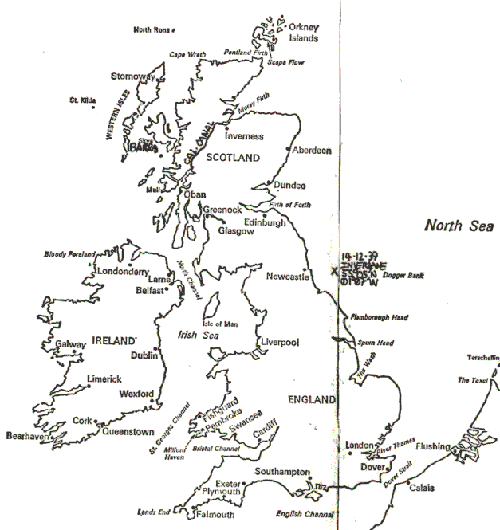
On U-123's second war patrol, which began on Thursday, 14 November, there was a tragedy aboard. En route to the operational area, on Sunday the 17th, Mechanikergefreiter Fritz Pfeifer was lost overboard, in we presume rough weather. Death may have been swift, or lengthy, depending on how good a swimmer he was. Cold November Atlantic water killed quickly, but not quickly enough. This incident was ironic, considering the fate they were about to serve to OB-244. An unknown number of Allied seamen died or drowned when U-103 and U-123 made contact after midnight on Saturday, 23 November, 1940. Slader writes that the five ships were sunk in five hours, the later and more thorough Blair writes that "Moehle made contact with OB-244 in the early hours of 22 November. In a remarkably dogged and aggressive series of attacks over the next thirty hours, Moehle sank six ships for 28,000 tons."(16)
Perhaps the man overboard incident was the motivation for this: a gritted-teeth desire to get something back for the loss of Pfeifer. More likely, with OB-244 dispersed and no longer escorted, there was every reason to keep pressing at the spreading field of ships, with enough fuel and torpedoes to justify the effort. What the seamen went through hardly bears imagining. They saw or heard other vessels picked off, not together which made the loss one incident, nor out of sight where it was more bearable. This happened in a drawn-out, grinding attrition, fraying on the nerves.(17) U-123 would have to surface, motor ahead, submerge again once another vessel was found, while torpedo-men laboured to reload the tubes, as Moehle and his officers worked out the next firing solution and worked their boat round to the best position. Moehle and his crew could not have made it quick and easy for their fellow mariners, even if they had wanted to. We cannot be sure when Oakcrest was torpedoed, working only off the information given by the U-boat Command record, which places her last among those lost. We know only she was hit - Jim never even recalled if it was night or day - and that she went down, in ballast, very quickly. Perhaps it was very early in the morning of the 23rd, if first contact with OB-244 was made after midnight on 22 November. U-123 was damaged during a submerged collision with a sinking ship and forced to return to Lorient, arriving safely on Thursday, 28 November, 1940. Perhaps it was Oakcrest, perhaps not. If she was the last, it probably was. Either way, circumstance and accident enabled some vessel to get a little back.
Passed by Moehle after four patrols to the ace KptLt. Reinhard Hardegen, in May 1941, who took him to the Eastern coast of the USA in the first German attacks on that coast, U-123 opened Operation Paukenschlag: paraphrased by western historians as "Drumbeat".(18)
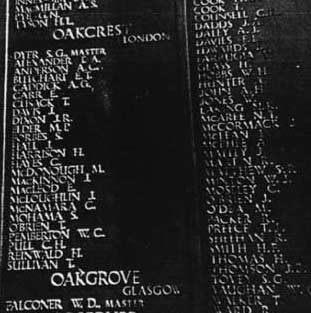 On Friday, 27 March, 1942 U-123 attacked the US Q-ship Atik (Carolyn) off the US East Coast. In the ensuing gunnery duel, Fähnrich zur See Rudi Holzer from U-123 was fatally wounded and died a few hours later, Atik being sunk. U-123, under Moehle, Hardegen, and then their respective second-in-command, Horst von Schroeter, from June 1942, damaged four ships of 31,000 tons and sank 47 merchant ships of 244,000 tons, and a submarine, in the course of 14 war patrols. U-123's luck continued to hold. On Sunday 7 November 1943, the U-boat was attacked by a Mosquito aircraft from 618 Sqn RAF, suffering 1 man dead and 2 wounded. He was decommissioned at Lorient on Thursday, 17 June, 1944, in the aftermath of the D-Day landings, and became a "school" or training boat, a Frontschulboot, until scuttled to prevent Allied use on 19 August, 1944, another Saturday. U-123 was surrendered intact in May 1945, and raised to serve in the French Navy as Blaison till 1959. He was stricken as Q-165 on 18 August 1965.(19)
On Friday, 27 March, 1942 U-123 attacked the US Q-ship Atik (Carolyn) off the US East Coast. In the ensuing gunnery duel, Fähnrich zur See Rudi Holzer from U-123 was fatally wounded and died a few hours later, Atik being sunk. U-123, under Moehle, Hardegen, and then their respective second-in-command, Horst von Schroeter, from June 1942, damaged four ships of 31,000 tons and sank 47 merchant ships of 244,000 tons, and a submarine, in the course of 14 war patrols. U-123's luck continued to hold. On Sunday 7 November 1943, the U-boat was attacked by a Mosquito aircraft from 618 Sqn RAF, suffering 1 man dead and 2 wounded. He was decommissioned at Lorient on Thursday, 17 June, 1944, in the aftermath of the D-Day landings, and became a "school" or training boat, a Frontschulboot, until scuttled to prevent Allied use on 19 August, 1944, another Saturday. U-123 was surrendered intact in May 1945, and raised to serve in the French Navy as Blaison till 1959. He was stricken as Q-165 on 18 August 1965.(19)
Left: The crew members of Oakrest lost at sea commemorated at Tower Hill.
Oakcrest is far less documented. There is no company history of Crest Shipping nor inherited corporate records. Where or when she was built, and her engine and worth are still a mystery. When torpedoed, she was in an outbound convoy, carrying no cargo, but ballasted, hence her tonnage of 3277, not the maximum 5407 according to Lloyd's War Losses. She was not carrying steel plate, these were a precious import, not a mere ballast. Her ballast "was probably steelworks slag: it was an easy way to get rid of it."(20)
The story of Inverlane and San Adolfo, too, was not exactly as Jim told it. Kelly was torpedoed, but in the North sea on 8 May, 1940, in action with her flotilla against German torpedo boats and destroyers. It is hardly credible a slow motor tanker, with 12,694 tons of invaluable fuel aboard, would stop or be allowed to stop, in the middle of a sea battle where torpedo-carrying fast attack craft had just seriously damaged a fast warship. Kelly had been mined in December 1939, in the North sea, right after her commissioning, going to the aid of a tanker which had just been mined. It is far more likely that fallible memory confused the two incidents. Jim remembered the mining, and Mounbatten's conversation with Inverlane's master, but not the date.
 Two things should be made clear, both about this story and the Battle of the Atlantic as a whole: the inaccuracy of shipping records, partly due to different tonnage definitions, and the fallibility of human memory and oral history. Oakcrest wasn't a coaster, merely old and outdated, wasn't carrying steel plate, but in ballast, and both the date and time of sinking vary: 22/11, 23/11 (British vs German Zone time), 25/11. Perhaps 20 died in the lifeboat: excluding the inevitable deaths from the torpedo hit, the pair lost astern in the first lifeboat, as well as the four definitely buried in lonely graves on Barra, visited by James' son, (the author's father) in 1993. There are 25 names from Oakcrest on the Tower Hill Memorial in London, for those 37,701 British merchant seamen, of both World Wars, who have no known grave.
Two things should be made clear, both about this story and the Battle of the Atlantic as a whole: the inaccuracy of shipping records, partly due to different tonnage definitions, and the fallibility of human memory and oral history. Oakcrest wasn't a coaster, merely old and outdated, wasn't carrying steel plate, but in ballast, and both the date and time of sinking vary: 22/11, 23/11 (British vs German Zone time), 25/11. Perhaps 20 died in the lifeboat: excluding the inevitable deaths from the torpedo hit, the pair lost astern in the first lifeboat, as well as the four definitely buried in lonely graves on Barra, visited by James' son, (the author's father) in 1993. There are 25 names from Oakcrest on the Tower Hill Memorial in London, for those 37,701 British merchant seamen, of both World Wars, who have no known grave.
These facts are not meant to undermine the credibility of Jim's story, nor to present 'the actual historical truth'. Absolute truth does not exist in any objective sense. These family tales were not intended as history. They had a different function. They preserved and recalled the events as the participants remembered them, not as officialdom or analysts would later, 'working in tranquility after the fact'. As such they functioned mythically. These stories included only what the participants considered important. They were the essence of the experience. Moreover they were therapeutic, the collection, arrangement, reuse and reworking of powerful traumatic memories into oral narrative with a highly personal purpose. They told the tales of fear and surprise and humour and worry, and of poor pay, food and conditions, the way the participants remembered it. The addition of documented fact does not invalidate them, nor make the tales better or less mythical.
The mindset of myth formed, and the force of the memories drove these accounts, even among those participants writing after the war. They knew the facts, and knew the difference between myth and reality. Yet these tended not to modify their feelings or impressions about their experiences or those they wrote about, for the consumption of the public. These myths, not lies or delusions, but just mythic retellings, are the core of memory and history about the Atlantic campaign. They are the reason it has survived as a monument to men's bravery and fortitude amid unimaginable fear and torment. Without them there would be merely tons of bare facts and statistics, and hyperbolic tales fit only for the pages of comics. Instead we have stories, the product of years of bearing scars and hidden traumas, soaked in feeling yet still devoid of sentimentality, which illuminate more than just facts and hype. These stories give off their own light and darkness, their own powers of resolution and malice. The greatness and the lowness of the Battle are both here.
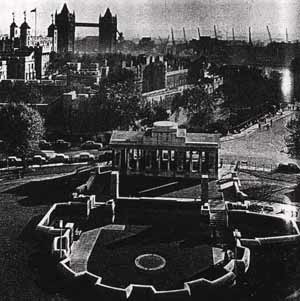 Left: The Tower Hill Memorial in London, lists 37,701 British merchant seamen from both wars without a known grave.
I intended it to be inserted in the existing text as indicated:
there is a paragraph beginning "the boat did not even safely beach....", the new stuff is replacing &
following that para, ending with "the survivors who died on Barra...": it just needs to
be dropped in, as if you were inserting a correction to the text; the images can go in
the way the existing images are: aerial views first, then ground distant shots, then
closeups on the graves etc.
---------------------------------------------------------
---------------------------------------------------------
Left: The Tower Hill Memorial in London, lists 37,701 British merchant seamen from both wars without a known grave.
I intended it to be inserted in the existing text as indicated:
there is a paragraph beginning "the boat did not even safely beach....", the new stuff is replacing &
following that para, ending with "the survivors who died on Barra...": it just needs to
be dropped in, as if you were inserting a correction to the text; the images can go in
the way the existing images are: aerial views first, then ground distant shots, then
closeups on the graves etc.
---------------------------------------------------------
---------------------------------------------------------
Notes
1. Slader, J., The Red Duster At War, William Kimber, London, 1988, p.92.
2. The recent documentary "Bulk Carrier", (Stone City Films for BBC, 1997) from the Disasters series, gives just one example of the c. 1 million tons of shipping lost every year, largely through lapses in standards from flags of convenience and poor maintenance and training, due to profiteering and funding shortfalls.
3. Alan Campbell, pers.comm; notes for the author, 1998, 1999.
4. Barra itself got into the news some six months later when a ship, SS Politician, wrecked on nearby Eriskay during a whisky shortage, carrying something in the order of 20,000 cases [240,000 bottles/200tons] of Whisky, most of which mysteriously disappeared in the following weeks...Inevitably fictionalised, by Compton Mackenzie, the book was called Whisky Galore, as was the movie, a masterpiece of the contemporary Ealing Tradition, and as much a cinema classic in its time as The DamBusters. The sequel, both an artistic and commercial failure, was called, naturally enough, Scotch On The Rocks! The last 14 bottles sold at auction in Glasgow for £12,012 in 1993.
5. 5) "I would give a lot to have the letter written to Jim's mother by the doctor on Barra in 1941.", Alan Campbell, op.cit.
6. He would always later recall the roof and wall blocks clicking, back and forth, against one another, as the ship rolled.
7. Ibid.
8. Hay, D., War Under the Red Ensign, Janes, London, 1982, p.169; Lane, T., The Merchant Seaman's War, Manchester University Press, Manchester, 1990, p.77-8, 82-3.
9. Those aboard Titanic, for instance, suffered this indignity.
10. Law in Howarth, S., & Law, D., (eds.), The Battle of the Atlantic, Greenhill Books, London, 1994, p.599.
11. Rössler, E., The U-boat: Evolution & Technical History, A&A Press, London, 1981, pp.103-5, 150-1.
12. Or rather him, as German and Russian parlance refers to ships and boats in the masculine.
13. Please see uboat.net's page on the Laconia Order.
14. At http://www.uboat.net/men/moehle.htm
15. At http://www.uboat.net/boats/u123.htm
16. Blair, C., Hitler's U-boat War: the Hunters 1939-42, (V.1 of 2), Weidenfield & Nicholson, London, 1997, p.208.
17. The ships were, in order from uboat.net's records, presumably from those of U-123:
| Date | C.O. | Ship | Tons | Registry | Convoy |
| 22 Nov, 1940 | Moehle | Cree | 4,791 | British | |
| 23 Nov, 1940 | Moehle | Kolchis | 2,219 | Greek | OB-244 |
| 23 Nov, 1940 | Moehle | King Idwal | 5,115 | British | OB-244 |
| 23 Nov, 1940 | Moehle | Anten | 5,135 | Swedish | OB-244 |
| 23 Nov, 1940 | Moehle | Tymeric | 5,228 | British | OB-244 |
| 23 Nov, 1940 | Moehle | Oakcrest | 5,407 | British | OB-244 |
18. Wise readers will know that Paukenschlag is a 'Drum-hit', not a "Roll on the Kettledrums."
19. At http://www.uboat.net/boats/u123.htm
20. Alan Campbell, op.cit.
About the author
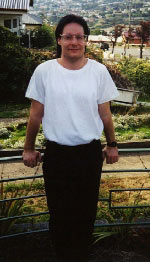 Ian Campbell was born in Tasmania in October 1970. The son of Scots-German parents, he was raised with a strong awareness of history, culture, and travel. The grandson of a World War II merchant seaman on one side, and a Desert Rat/D-Day veteran on the other, these led to a lifelong interest in the sea and shipping, as well as writing and depictions of maritime, naval, aviation and spaceflight and associated subjects.
Ian Campbell was born in Tasmania in October 1970. The son of Scots-German parents, he was raised with a strong awareness of history, culture, and travel. The grandson of a World War II merchant seaman on one side, and a Desert Rat/D-Day veteran on the other, these led to a lifelong interest in the sea and shipping, as well as writing and depictions of maritime, naval, aviation and spaceflight and associated subjects.
He completed two theses and several articles (also on the web) on the Bounty mutiny and Pitcairn, stemming from a sailing trip to Pitcairn with his parents for its Bicentennial in 1990.
Ian completed an MA in History on World War I and World War II naval mythology and representations, as seen via books, novels, cinema and documentary, in August 2000, from which much of his expertise and special knowledge stems. It was through this thesis that he found uboat.net and began to contribute to it.
He welcomes your comments on this article. You can write to him at habu974@yahoo.com.
This article was published on 23 Apr 2002.

